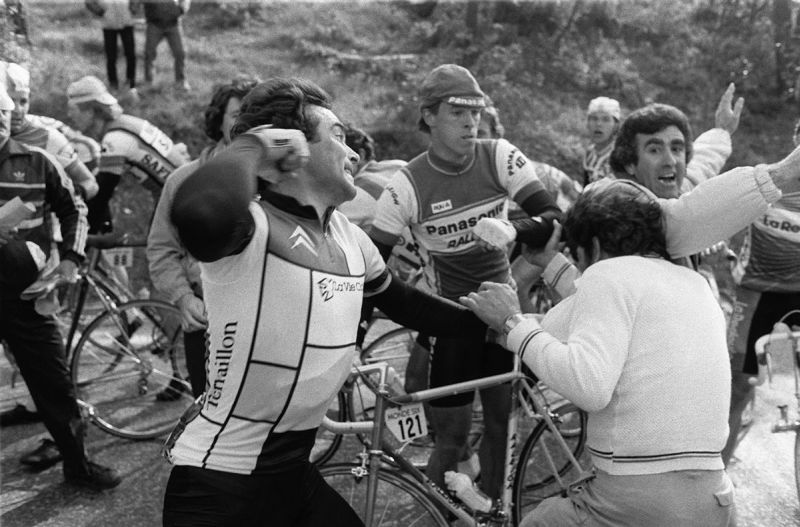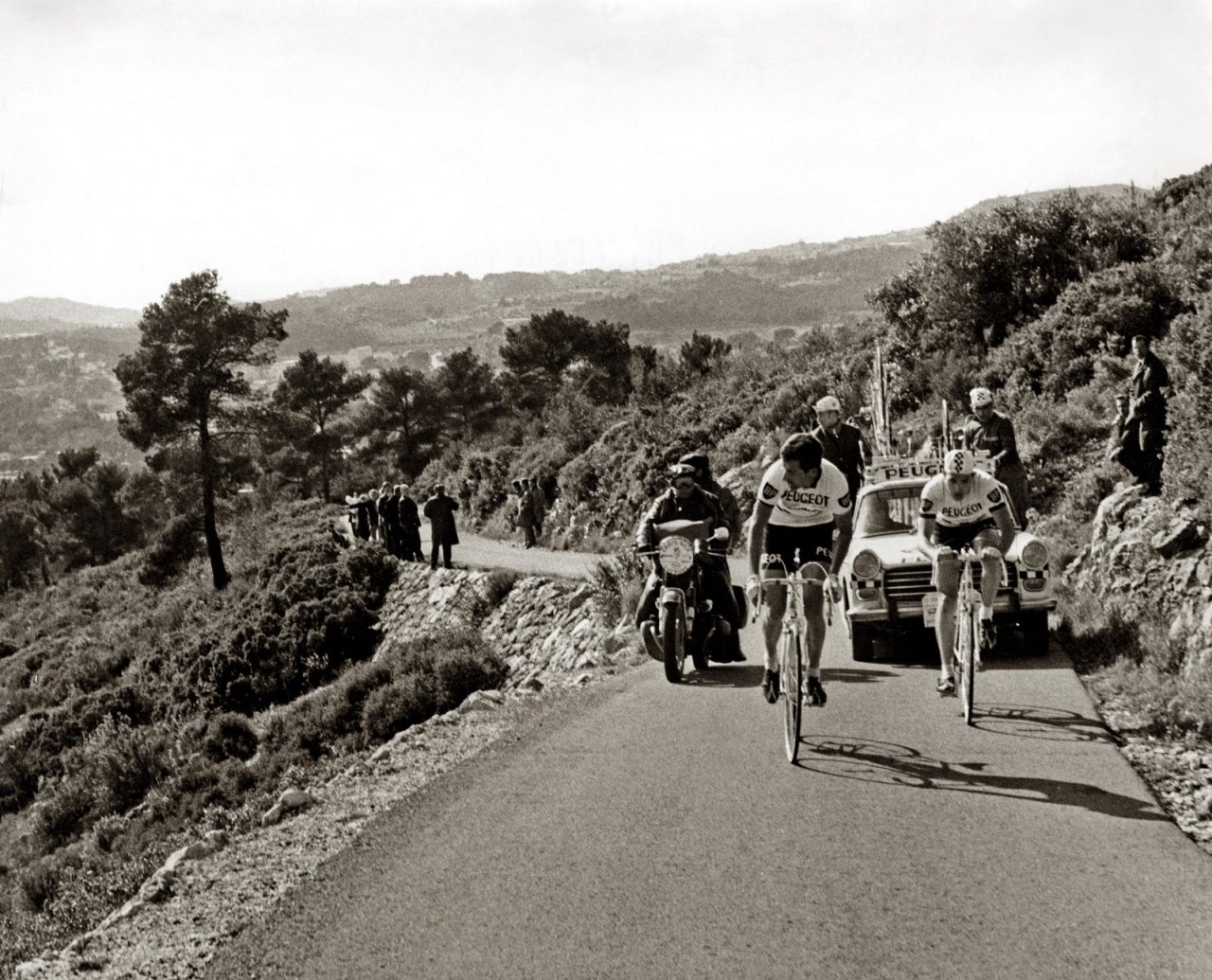With Paris-Nice on, time to look back at the race’s history. Over the years it has welcomed exotic teams, transported riders by air and invented new race rules. Through the race’s history we can trace the evolution of the sport we know today.
Local history
150 years ago and the Mediterranean coast of France was no more than a collection of fishing villages. The Riviera we know today, with its hotels, beaches and bustle is a modern thing. Throughout the second half of the 19th century, aristocrats from northern Europe began to congregate on the south coast around Nice. Russia’s imperial family regularly spent their winters there. Their wealth followed and contributed towards the construction of a coastal railway line and tourism grew. American entrepreneurs apparently imported sand to create the beach in Cannes, the town now famous for its film festival.
Despite the spread of the motorcar and a growing railway network, in the 1930s France was still a vast country. Historian Fernand Braudel wrote of the “tyranny of distance”. With different climates, diet and vegetation, Nice and Paris might be in separate countries. What better way to link them than a bike race?
From the track to the open road
One man with a foot in both cities was Albert Lejeune, owner of Le Petit Journal, a Parisian newspaper and Le Petit Niçois, a Nice-based newspaper. Le Petit Journal was one of the first newspapers to back cycling. In 1891 its editor Pierre Giffard started the Paris-Brest-Paris race. Lejeune hit on the idea of a race to rival the six day races on the track, using roads to provide readers with more drama. Six day racing was very popular but the riches went to the promoters from ticket sales rather than the newspapers covering them. Thus the Six Jours de la Route race started in 1933, the “six days of the road” and it allowed the stars of the sport a chance to get used to tarmac after a winter spent on the boards.
After launching Paris-Nice Lejeune’s career took a notable twist. He moved to L’Auto – , forerunner of L’Equipe today and the newspaper that ran the Tour de France – in 1939 and became its president in 1941. France was occupied by Germany and Lejeune used L’Auto to support the Nazi regime, a role which saw L’Auto dismantled after the war and Lejeune was put on trial for collaboration and executed in 1945.
Back to the sport and the race is a mini Tour de France normally with short time trials and reduced summit finishes and even if this year’s edition lacks these ingredients, it’s got several sharp uphill finishes. But the early versions of Paris-Nice were designed to help ease track cyclists onto the road and the race stuck to the flat Loire and Rhone valleys instead of deviating to nearby mountains. The first version started outside the Café Rozes on the Place d’Italie in Paris.
Since its creation the race has changed format considerably. War interrupted the race but once the conflict and occupation ended, it was only run in 1946 before it returned in the 1950s. In 1951 it was reborn as “Paris – Côte d’Azur” and finally in 1954 it took the name Paris – Nice. But not for long as it later became Paris – Nice – Rome but the 2,000km run was considered too much and it returned to being a French race.
Leulliot, the innovator
Jean Leulliot became the full time race organiser in the late 1950s. First a journalist, he had worked for L’Auto and during the war years he ran the Circuit de France, a copycat race mirrored on the Tour de France but this was a dismal failure on all fronts: sponsors were scared away, some of the results were falsified and at the end of the war Leulliot faced trial for collaborating with the Nazis. Luckily for cycling he was cleared as he was a force of innovation.
- A pioneer of women’s racing he started the Tour de France féminin in the 1950s.
- He started the “Petit Tour de France” for amateurs and independent pros, a forerunner of the Tour de l’Avenir today.
- In 1963 he organised the first air transfer, taking the riders to Corsica for a stage.
- He also invented the concept of the prologue for the 1968 edition of Paris – Nice.
- The same 1968 race listed a Meilleur Descendeur prize for the fastest rider down Mont Faron… sponsored by a ski manufacturer. Thankfully for rider safety this downhill innovation didn’t survive.
- In 1972 he introduced the “kilometre rule” meaning crashes in the last moments of the race didn’t penalise a rider’s overall position. This rule has since been extended to three kilometres.
- The 1974 race was made open to amateurs, a means to allow Eastern Bloc riders to take part. Poland’s reigning world champion Ryszard Szurkowski impressed with high placings but ultimately the Western pros won everything. The race was televised in Poland.
- His daughter Josette invited a Japanese team in 1988. None made it to the finish.
He died in the 1980s and his daughter Josette ran the race. The race was then bought by Laurent Fignon, the French champion retired but could not shake what the French call the virus de cyclisme and a champion on the bike, Fignon found himself in the deep end when it came to dealing with local mayors, co-ordinating police escorts and gathering sponsors. But he succeeded, just, and eventually sold the race to ASO.
Battles and rivalries
The race has attracted champions and developed its own myths and legends over the years. 1966 saw the rivalry between Raymond Poulidor and Jacques Anquetil reach a new level. To the surprise of many Anquetil was beaten by Poulidor in the time trial stage but took the lead back on the final stage. But the race was not over as the official results were not agreed until well after the race finished as Poulidor’s camp accused Anquetil’s team of using physical force to ride Poupou off the road. Finally Anquetil won.
By 1972 Anquetil was helping to organise the race but Poulidor’s life wasn’t any easier since he had to contend with Eddy Merckx in full cannibal mode. The Belgian was dominating everyone, going for intermediate sprints, tussling for bunch sprints and with one stage to go, in the overall lead too. The prize that year was a motor boat and Merckx was so confident on the morning of the final stage he posed for a photo session with “his” prize. But race organiser Leuillot needed some drama and offered Poulidor 10,000 francs if he won. The incentive worked and the Frenchman beat Merckx.
The race took an Irish twist in the 1980s with Stephen Roche and Sean Kelly battling for the win. Roche won in 1981 as a neo pro. Then Kelly took the race every year from 1982 until 1989.

Paris not so nice
It might be the race to the sun but often the riders face grim conditions on the way. In 1951 the local government ordered a gang of labourers to clear the Col de la Batterie of snow ahead of the race. Often whole stages have been ridden whilst the snow falls and in 1980 the riders finally had enough of this and protested, organising a peloton strike. But as usual in cycling, the bunch didn’t unite and only 43 riders took part and the race organisers threw 11 of them out of the race. In 1982 up to 300 protestors blocked the road and Bernard Hinault took it up on himself to clear some of them out of the way. In 1994 the race embraced the snow and finished in the ski station of Vaujany but the race has never had an Alpine feel, March is simply too cold to venture in the Alps
Today
Race organiser ASO is a conservative business and its races often reflect this. All of its races had settled into a pattern but there’s a spark of innovation in the new team led by Christian Prudhomme and it’s visible this week in the unconventional route.
Past winners
| 7 | Sean Kelly | 82, 83, 84, 85, 86, 87, 88 |
| 5 | Jacques Anquetil | 57, 61, 63, 65, 66 |
| 3 | Eddy Merckx | 69 70, 71 |
| 3 | Joop Zoetemelk | 74, 75, 79 |
| 3 | Laurent Jalabert | 95, 96, 97 |


Not an innovation by initiative, but the tragic death of Andrei Kivilev in 2004’s race, changed the helmet-enforcing rule in pro-cycling.
And after that several more riders died of headwounds with helmets on. Doens’t really help anything.
Quote source please. Sounds like drivel.
http://www.ncbi.nlm.nih.gov/pmc/articles/PMC2598379/
http://www.smf.org/docs/articles/report.html
I rarely moderate comments beyond the spam nonsense but a gentle warning if this is going into another helmet war I’ll lock things if necessary. Sorry 😉
Kivilev death was in 2003
That photo of Hinault has to be from 1984, first year in La Vie Claire team kit. Quite the classic photo, a cornerstone of the Badger’s reputation.
The full story on the Hinault punch http://inrng.com/2012/03/the-story-of-the-hinault-photo/
He never won this race.
Never heard the Poulidor/Merckx story before. I wonder, did Pou Pou offer a share of the winnings for Eddy to sit up at the finish? Or was The Cannibal beaten fair/square?
Beaten fair and square apparently, Merckx thought he had it all wrapped up but Poulidor reversed this on the final stage.
With that jaw is it Phil Anderson (Aust) landing a left cross to the back of the guy’s head in the Hinault shot?
Yes. Look closely on the left and there’s Stephen Roche
Photo at the top of the page is of Tom Simpson and a young Eddy Merckx in 1967 during their breakaway. They stayed away to the finish where Eddy won the stage and Tom took over the jersey which he held to the end.
Mike